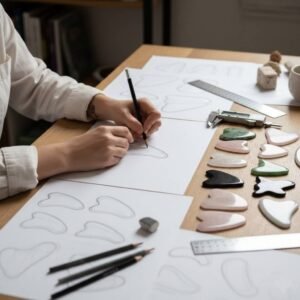
- I. Introduction
- II. Gua Sha History
- III. Gua Sha Benefits
- IV. How to Use Gua Sha on Face
- V. How to Use Gua Sha on Body
- VI. Gua Sha Precautions
- VII. Conclusion
- Gua Sha Tool Recommendations
- Gua Sha Tool Shapes
- Gua Sha Tool Materials
I. Introduction
- Definition of Gua Sha
Gua sha is an ancient Chinese healing technique that involves using a flat tool, such as a jade or rose quartz scraper, to scrape the skin in a specific direction. The technique is also known as “gua sha” and is commonly used in Traditional Chinese Medicine to promote healing and relieve pain.
- Brief Overview of the Topic
In recent years, gua sha has gained popularity in Western countries as a natural remedy for various health conditions, including pain and inflammation. While gua sha has been used for thousands of years in Chinese medicine, its potential benefits and effectiveness have only recently been studied in Western medical research.
II. Gua Sha History
- Origin of Gua Sha
Gua sha has been used in Traditional Chinese Medicine for thousands of years, and its exact origin is not known. The practice is believed to have originated in Southeast Asia and spread to other parts of Asia, including China.
- Traditional Uses of Gua Sha in Chinese Medicine
Traditionally, gua sha was used to treat a variety of conditions, including fever, colds, digestive disorders, and muscle pain. In Chinese medicine, the technique is believed to promote the flow of “qi” or energy in the body, which is essential for good health.
III. Gua Sha Benefits
- Overview of the Potential Benefits of Gua Sha
Gua sha is believed to have several potential health benefits, including pain relief, reduced inflammation, improved circulation, and relaxation. The technique is also thought to help detoxify the body and boost the immune system.
- Research Studies Supporting Gua Sha Use for Pain and Inflammation
Several research studies have suggested that gua sha may be effective in reducing pain and inflammation. For example, a study published in the Journal of Pain found that gua sha was more effective than a placebo in reducing neck pain in patients with chronic neck pain.
- Other Potential Benefits of Gua Sha, Such As Improved Circulation And Relaxation
In addition to pain relief and reduced inflammation, gua sha may also help improve circulation and promote relaxation. One study published in the Journal of Traditional Chinese Medicine found that gua sha increased blood flow in the skin and improved microcirculation. Another study suggested that gua sha may help reduce anxiety and promote relaxation.
IV. How to Use Gua Sha on Face

- Step-By-Step Guide on How to Use Gua Sha on the Face
To use gua sha on the face, follow these steps:
- Apply a facial oil or serum to the face.
- Hold the gua sha tool at a 15-degree angle against the skin.
- Start at the center of the forehead and gently scrape the tool upwards towards the hairline.
- Move down to the temples and scrape towards the ears.
- Next, scrape under the cheekbones towards the ears.
- Use the curved side of the tool to gently scrape under the eyes and over the eyebrows.
- Finally, scrape from the chin towards the ears.
Benefits of Using Gua Sha on the Face
Using gua sha on the face may help promote circulation, reduce puffiness, and improve skin elasticity. It may also help reduce the appearance of fine lines and wrinkles.
Precautions to Take When Using Gua Sha on the Face
When using gua sha on the face, be gentle and avoid applying too much pressure. It’s also important to use a facial oil or serum to provide lubrication and protect the skin from damage.
V. How to Use Gua Sha on Body
Step-by-Step Guide on How to Use Gua Sha on the Body
To use gua sha on the body, follow these steps:
- Apply a massage oil or lotion to the skin.
- Hold the gua sha tool at a 15-degree angle against the skin.
- Start at the top of the body and work downwards, gua shathe tool in long strokes towards the feet.
- Use a gentle, fluid motion and adjust the pressure to avoid causing pain or discomfort.
Focus on areas of tension or pain, such as the neck, shoulders, and back.
Benefits of Using Gua Sha on the Body
Using gua sha on the body may help relieve muscle tension, reduce inflammation, and promote relaxation. It may also help improve circulation and boost the immune system.
Precautions to Take When Using Gua Sha on the Body
When using gua sha on the body, be careful not to apply too much pressure, especially on bony areas such as the spine. It’s also important to use a massage oil or lotion to provide lubrication and protect the skin from damage.
VI. Gua Sha Precautions
Precautions to Take When Using Gua Sha
When using gua sha, it’s important to take the following precautions:
- Be gentle and avoid applying too much pressure to the skin.
- Use a lubricant, such as a massage oil or serum, to protect the skin from damage.
- Clean the gua sha tool thoroughly after each use to prevent the spread of bacteria.
- Do not use gua sha on broken skin or over areas with active infections.
Who Should Not Use Gua Sha
Gua sha may not be suitable for everyone, including people with certain medical conditions or those taking certain medications. It’s important to speak with a healthcare provider before using gua sha.
Possible Side Effects of Gua Sha
Possible side effects of gua sha include bruising, redness, and soreness. These side effects are usually mild and temporary.
VII. Conclusion
Summary of the potential benefits of gua sha for pain and inflammation
Gua sha may be helpful in reducing pain and inflammation, as well as promoting circulation, relaxation, and overall well-being.
Final thoughts on gua sha use for specific health conditions
While gua sha may be helpful for certain health conditions, it’s important to speak with a healthcare provider before using the technique. It’s also important to follow proper precautions and
Gua Sha Tool Recommendations

1. Recommended Gua Sha Tools for Beginners And Advanced Users:
- Beginners: A flat, stainless steel gua sha tool is a great option for beginners as it is easy to use and affordable.
- Advanced users: For those looking for a more specialized tool, a curved or comb-shaped tool made of jade or rose quartz may be a good choice.
2. Considerations When Purchasing Gua Sha Tools, Such As Quality And Price:
- Quality: Look for gua sha tools that are made from high-quality materials and are durable enough to last over time.
- Price: Gua sha tools can range in price, so consider your budget and whether you are willing to invest in a higher-end tool for more advanced use.
Gua Sha Tool Shapes
1. Overview of the Different Shapes of Gua Sha Tools:
Flat: These gua sha tools have a smooth, flat surface and are ideal for larger areas of the body, such as the back.
Curved: These gua sha tools have a curved surface and are great for areas of the body that have a more defined contour, such as the neck and face.
Comb-shaped: These gua sha tools have teeth-like ridges and are perfect for stimulating the scalp and promoting hair growth.
2. Advantages And Disadvantages of Each Shape:
Flat: Advantages include their versatility and ability to cover large areas quickly. However, they may not be as effective for smaller, more intricate areas.
Curved: Advantages include their ability to contour to the shape of the body and reach more specific areas. However, they may require more time and precision to use effectively.
Comb-shaped: Advantages include their ability to stimulate the scalp and promote hair growth. However, they may not be as effective for other areas of the body.
Gua Sha Tool Materials
1. Overview of the Different Materials Used for Gua Sha Tools:
Jade: This is a popular choice for gua sha tools due to its natural cooling properties and ability to promote lymphatic drainage.
Rose quartz: This is another popular choice for gua sha tools due to its calming and soothing properties.
Stainless steel: This is a more affordable option for gua sha tools and is durable and easy to clean.
2. Advantages And Disadvantages of Each Material:
Jade: Advantages include its natural cooling properties and ability to promote lymphatic drainage. However, it may be more fragile and prone to cracking or breaking.
Rose quartz: Advantages include its calming and soothing properties. However, it may be more fragile and prone to cracking or breaking.
Stainless steel: Advantages include its durability and affordability. However, it may not have the same cooling or soothing properties as natural materials.






